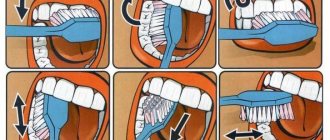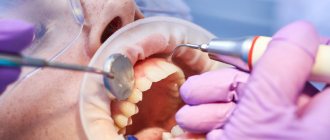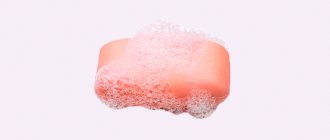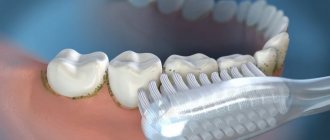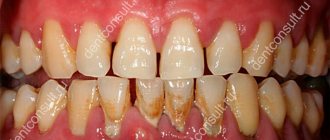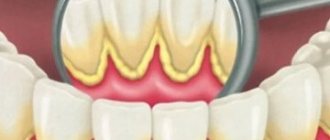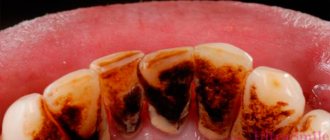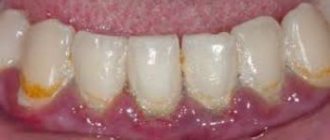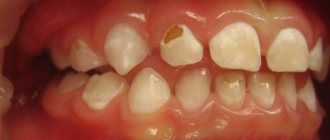Why plaque and stone are dangerous
The plaque that settles on the teeth is soft. It can be easily removed with any hygiene products. Within 6-12 hours it reacts with the components of saliva, becomes saturated with calcium salts and hardens. The only way to prevent this is to use mouthwash throughout the day. Once the plaque has hardened, it can no longer be removed.
Tartar gradually forms. It continues to grow as new layers of plaque easily “stick” to the rough surface. After about 6 months it becomes visually noticeable, but this is not its main danger.
The stone grows in the cervical part of the crown, gradually penetrating into the subgingival area. This leads to mechanical damage to the gums and loosening of the teeth. Microorganisms cause gum inflammation and provoke more severe oral diseases. Patients complain of bleeding and sensitivity of the gums, and bad breath. With further growth of the stone deeper into the gums, there is a risk of developing cysts on the root of the tooth.
Choosing the right brush is already half the battle
When hard plaque appears on your teeth, you need to approach the choice of brush very responsibly. What parameters should it have?
- Be multi-tufted with rounded edges and man-made fibres.
- Have a small nozzle.
- Have medium hard bristles.
Electric and ultrasonic brushes get good reviews.
Electric brushes make a large number of movements in one minute. With the help of pulsation, partially mineralized plaque is broken up.
Ultrasonic brushes have a specially built-in generator that generates oscillatory ultrasound waves. They can remove small hard deposits.
Causes of congestion
- Insufficient oral hygiene, incorrectly selected hygiene products.
- Eating a lot of sweets, sticky foods, rich in light carbohydrates, and at the same time a small amount of solid foods, such as vegetables, in the diet.
- Abuse of products that have a coloring effect. Tea, coffee, cola, carbonated drinks - all this leads to the fact that the plaque turns brownish and, after hardening, spoils the smile.
- Diseases of internal organs. Patients with diseases of the gastrointestinal tract and endocrine system are prone to the formation of plaque on their teeth.
- Partial edentia, malocclusion, severe crowding of teeth.
Patients with bridge prostheses are at risk. The bridge is fixed on the supporting tooth. Food particles get trapped under the crown. In this case, cleaning plaque on teeth with conventional means is impossible. As a result, it grows, microorganisms attack the gums and supporting teeth, and it becomes mobile. If you have dentures, you should definitely visit your dentist for professional cleaning.
Step-by-step instruction
Cleaning steps
So, what does peroxide give us if it is applied to the surface of a tooth with pronounced plaque:
- The process of oxidation of stones occurs, they become loose.
- Completely suppresses bacterial flora, strengthening soft tissues.
- Does not destroy enamel, does not remove minerals from its composition.
Removing tartar with hydrogen peroxide has its own nuances that should be observed:
- Use only 3% peroxide, as higher concentrations can cause burns to the mucous membrane.
- Never use this product in its pure form. Always dilute with water.
- While fighting tartar, avoid eating sweets, coffee and black tea.
- After cleaning, it is not recommended to drink or eat for about 2 hours.
Remember that the process of dealing with persistent plaque does not mean rinsing your mouth with peroxide once. The process is long, but the result will exceed all your expectations, believe me.
Cleaning tartar with hydrogen peroxide is carried out in several stages:
- Applications - dilute 1 tablespoon of hydrogen peroxide and half of clean warm water in a glass container. Soak a cotton pad in the resulting liquid and apply to problem areas. Leave for 10 minutes, while using your hands to firmly press the disc against the gum area. After 10 minutes, the mouth should be rinsed with warm water. Applications are carried out daily for 5-7 days.
- Mouth rinse - dissolve 3 tablespoons of peroxide in half a glass of warm water. Rinse your mouth after every meal for a week.
- Abrasive cleaning is the final stage, when it is already possible to trace positive dynamics, but not all of the deposits have gone away. You need to apply a few drops of peroxide to a hard toothbrush and thoroughly brush all your teeth.
Usually this sequence of actions is enough to dissolve plaque and make your teeth as snow-white as possible.
Precautionary measures
When we remove tartar with hydrogen peroxide, we get not only a new smile, but also health. Everything that is done should be related primarily to oral health, and then to aesthetics. Peroxide allows you to remove harmful bacteria without disturbing the natural balance of microflora. To avoid any problems when using this method of fighting tartar, always follow these precautions:
- Do not swallow peroxide as it may cause stomach pain and discomfort.
- Do not use the method if your gums are bleeding excessively, or if you have progressive periodontal disease.
- Always pay attention to how you feel after the procedure. If there are no unpleasant sensations, then continue fighting the stone.
Experts do not recommend using peroxide for longer than 7 days. If it was not possible to remove the stone during this time (this happens with long-term persistent deposits), then the problem should be solved together with the dentist.
If pain, discomfort, or ulceration of the mucous membrane occurs, the use of peroxide should be discontinued immediately. Don't think that the more you apply to your tooth, the whiter it will be. This doesn't work because color is formed from a number of internal factors.
The most important advice that you must learn: peroxide is not a panacea! If you have serious problems with your teeth, or there are acute and chronic infectious and inflammatory processes in the oral cavity, then it is better to immediately contact a specialist and not self-medicate. While you are hoping for peroxide, time is ticking. If there are no noticeable results, and the condition of your teeth is only worsening, then, unfortunately, you cannot do without a doctor.
Types of plaque
- Soft. Formed on teeth during human life. It is not noticeable on the surface of the enamel and is easily removed from it using hygiene products.
- Solid. Once hardened, it is almost impossible to remove plaque from teeth at home.
- Supragingival stone. Formed from hard plaque. Outwardly it looks like a small dark-colored rim in the cervical area.
- Subgingival stone. It is formed under the gum, so it is not visually noticeable. It can only be detected using a special dental probe or an x-ray. If subgingival stone is not removed in time, gum resection may occur.
What is tartar
Microbes settle on the enamel during food consumption and digestion and multiply under the influence of a moist, warm environment near the gums. If they are not removed within the next fifteen hours, the process of mineralization of these organisms will begin.
After seven days, mineralization becomes irreversible, and after six months, the “dead” microorganisms turn into natural stone, the shade of which varies from yellow to dark brown.
Thus, up to 30% of tartar consists of organic compounds, and the amount of inorganic components gradually increases from 70 to 90%.
Additional Information. It is necessary to understand that the composition is not constant and varies depending on the period of mineralization. The amount of organic matter decreases with each day of hardening.
Remember that after just a couple of days of lack of careful hygiene, the film forms a rough surface that attracts even more plaque.
In addition, the occurrence of gum inflammation is beneficial to the stone, since this increases the amount of periodontal fluid, which contains the necessary salts and proteins to increase the colony of microorganisms and further mineralization.
Home Remedies
Home remedies for plaque removal are rather preventative. In order to maintain dental health, it is necessary to follow the rules of hygiene:
- Brush your teeth twice a day with a toothbrush and suitable toothpaste.
- Use toothpicks and dental floss after meals, as the brush cannot reach hard-to-reach places.
- Use mouthwash regularly.
Small plaque can be removed using pastes containing abrasives or tooth powder. When using them you need to be careful, as you can damage not only the enamel, but also the mucous membrane of the gums. You need to be even more careful if you decide to remove plaque from your teeth with whitening agents - soda, hydrogen peroxide. Their uncontrolled use can cause problems with dental health.
Classification of plaque by location
- Deposits on visible surfaces where they can be easily removed;
- Plaque under the gum (in the pocket) requires professional hygiene and causes inflammatory processes.
Plaque is diagnosed independently - local changes in the color of the enamel can be seen by looking in the mirror.
If the deposits are minor or are located in hard-to-reach places, they can be diagnosed with special substances that color the plaque.
Preventive visits to the dentist will help keep your mouth clean. Only a specialist can identify the problem in a timely manner.
Subsequent processing: fluoridation + polishing
A mandatory step after brushing (except for Air-Flow) is teeth polishing. After the procedure, the enamel becomes slightly rough, as microscopic particles of stone and mechanical irregularities remain on it. If the surface of the teeth is not polished, plaque will settle much more intensely than before brushing.
For polishing, use special brushes or a water-air jet with an abrasive mixture.
To reduce tooth sensitivity after the procedure and strengthen the enamel, special compounds with a high content of sodium fluoride are applied to the surface of the teeth. The procedure is not mandatory, but its implementation will help to quickly restore damaged layers.
Stone removal with 20% discount
Moscow
Contraindications
The most important contraindication is the presence of a pacemaker in the patient. Ultrasonic waves can disrupt its operation.
Other restrictions also apply to health conditions:
- asthma, bronchospasm, tuberculosis,
- increased risk of bleeding,
- allergies to the drugs used,
- infectious and viral diseases,
- oncology,
- mental illness, epilepsy.
Attention: Relative contraindications are pregnancy (first trimester), childhood (up to 16-18 years). The decision to perform the procedure is made by the dentist.
An electric toothbrush -
Oral-B toothbrushes have a round rotating head with bristles, which in standard mode makes 8,800 rotational and 20,000 pulsating movements per minute. Pulsating movements loosen plaque, and rotational movements sweep it away from the teeth and polish them. It must be said that such brushes are 2 times better at removing plaque (compared to ordinary manual toothbrushes), but usually even they can no longer cope with tightly attached plaque. Therefore, we will use such a brush with a special paste.
For our purposes, it is better to choose a toothbrush model that, in addition to the traditional “Daily Cleaning” mode, will have a “Whitening/Polishing” or “For Sensitive Teeth” mode. This is necessary so that the brush operates at lower speeds, because in this case, “faster does not mean better.” And keep in mind that electric brushes with a different operating principle (for example, sonic or ultrasonic) are not suitable for our purposes.
My electric toothbrushes -
The first photo shows my first toothbrush, “Oral-B PRO 500 CrossAction” (it’s a great brush, but I don’t use it anymore). This is an excellent brush for hygiene, but there is only 1 operating mode, “Daily Cleaning,” in which the nozzle makes 8,800 reciprocating and 20,000 pulsating movements per minute. This mode is not very suitable for polishing teeth with special pastes, because... the paste will splash heavily at high speed, and besides, such pastes remove dental plaque better at low speeds.
The second photo shows the Oral-B Genius 9000 toothbrush, which I have been using for the last 3 years. This model has many modes, including the “Whitening/polishing” mode we need. Another important detail - for our purposes, the most suitable type of attachments is “Precision Clean” (see photo below), which almost exactly resembles polishing brushes in a dentist’s office. Well, in the next section we will move on to discussing polishing agents.
Is ultrasonic teeth cleaning harmful?
Ultrasonic cleaning does not pose any threat to teeth and the body as a whole. An exception is situations in which the technology is broken or the patient has contraindications. Ultrasound can damage enamel if it is thinned or has such a structural feature. Sometimes brushing causes bleeding from the gums. The doctor will help stop it and advise what needs to be done for speedy healing.
Advice: to avoid possible troubles, before starting the procedure, the dentist finds out the state of health, concomitant diseases, and reaction to medications. Answer honestly and directly, every nuance matters.
When is it necessary to do preventative stone cleaning?
Optimally – 2 times a year to prevent caries and other problems. If there is an urgent need for this, according to the dentist, a maximum of 3 times a year, but not more often. Excessive exposure to tooth enamel can also negatively affect the condition of teeth - everything is good in moderation.
A preventive technique for cleaning teeth from plaque helps:
- get rid of the unpleasant feeling of a “rough film” on the teeth;
- lighten teeth several shades;
- provide powerful prevention of caries and gum disease;
- reduce the risk of more serious dental diseases, which lead to their loosening and complete loss;
- remove “smoker’s plaque”, which cannot be removed with a regular brush and paste;
- prepare teeth for prosthetics, implantation, whitening;
- improve the condition of your teeth after wearing braces;
- keep the cavity in perfect order.
